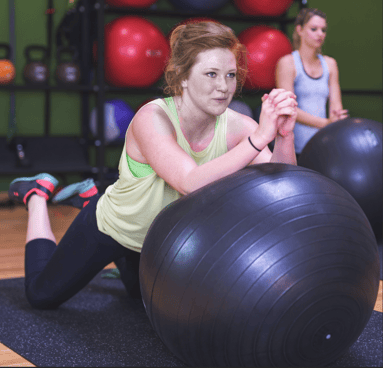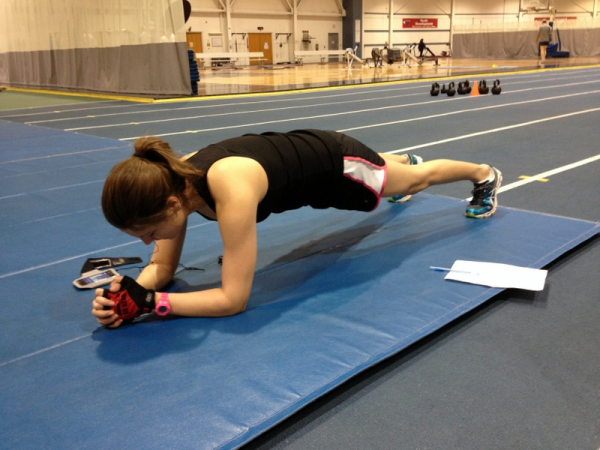
Every day I work with about 90 athletes, and almost half of them ask if they can do more “abs.” Most athletes don’t understand how much core to do, what exercises to perform, when to do it, or how to program for it. They just want to “feel the burn.” In this blog I explain a smarter approach to training the core and where to put it into your program so that you can begin to train the core correctly and perform better at your respective sport.
The Core Exercises That Athletes Usually Do
Before I go into what athletes need to be doing, here is a look at what most athletes do on a regular basis. Following is a list of movements and exercises that coincide with each other. If you notice, in each of these, the core acts as a primary mover. Is this really a smart way to train?
- Trunk flexion–sit-up variations, crunch variations
- Trunk extension–back extensions
- Trunk lateral flexion–side bends
- Trunk rotation–medicine ball (MB) twists and throws
When athletes compete in the field of play, do you ever see them hunch over similar to a sit-up? I don’t. Do you ever see an athlete do side bends? I don’t. I do think that MB rotational tosses do have their place in programming, but I think a greater emphasis needs to be on preventing movement from occurring rather than using the core as a primary mover.
A Smarter Approach to Training the Core
Here is a smarter approach to training the core. I believe that enhancing core stability is a much smarter way to train. The five branches of core stability include anti-extension, anti-lateral flexion, anti-rotation, hip flexion with a neutral spine, and anti-flexion. Let’s break down each component and give you practical examples for the next time you’re in the gym.

Anti-extension: The goal of anti-extension exercises is to resist extension through the lumbar spine. This is probably the most poorly executed out of the five categories. Most would improve by simply completing push-ups and planks with a neutral spine. As you develop strength in this area, you can progress to rollout variations. The most important thing is to keep the spine neutral and not allow it to hyperextend.
Anti-lateral flexion: Whenever you walk into the gym, you are bound to see someone with one dumbbell or kettlebell in their hand and doing side bends. This is one of those exercises where you are sore for days and you think that it’s a great e xercise. Am I right? But the goal here is to actually resist lateral flexion or side bending. So if we can’t do side bends, what do we do? Try holding a dumbbell in one hand for an extended period of time without allowing side bending. You can progress to a walking suitcase carry or waiter’s carry, holding the weight in one hand while extended overhead. You can also try suitcase deadlifts. Lock your spine into place and don’t let it move!
xercise. Am I right? But the goal here is to actually resist lateral flexion or side bending. So if we can’t do side bends, what do we do? Try holding a dumbbell in one hand for an extended period of time without allowing side bending. You can progress to a walking suitcase carry or waiter’s carry, holding the weight in one hand while extended overhead. You can also try suitcase deadlifts. Lock your spine into place and don’t let it move!
Anti-rotation: As I have already mentioned, I still believe in medicine ball rotational exercises, especially for rotational sports, but I have put a greater emphasis on resisting rotation through the core and lumbar spine. The exercise that I use most often for this category is the Pallof Press. The most important coaching cue here is to lock the core down and not allow any rotation through your spine.
Hip flexion with a neutral spine: This is exactly what it sounds like. While keeping your back straight, you flex the hips. Examples here include stability ball jack knife, TRX Crunch, Valslide Hip Flexion (mountain climber), and even hanging leg raises.
Anti-flexion: Finally, anti-flexion is the last component to core training. This component is used a lot of times without even programming for it. Any time you do any type of deadlift variation or squat variation, you are training anti-flexion. The goal here is to just resist flexion, or bending, through the spine.

Programming Core Training into Your Workout
Now that you know and understand the different types of exercises that can improve your performance the most, let’s talk about where to put it into your program. Some people think core training should be done at the beginning and others think it should be completed at the end of your workout. Here is my response. I think you should do it at the beginning and use it as a branch-off of your mobility/corrective or activation work. After all, it would be smart to activate your core before you work out since you will be using it for a lot of your different movements.
Lastly, how much core should you do each day? The way that I program our workouts is simply taking one to three of those categories and picking one exercise for each. Make sure that you do each one the same amount to ensure a balanced program. If you choose only one exercise, you could do three sets or so. But if you choose to do more than one exercise, anywhere from one to three sets would be sufficient.
Hopefully you have a better understanding of why core stability is important. Give this a try and you will soon find out that preventing movement from occurring will improve your overall athletic performance.
Need more help with Core training? Try one of these great group fitness classes designed specifically to target the core. Core and More, Extreme Core, and Les Mills Core®.
This blog was written by trainer Josh Jones, MS, CSCS, USAW, NIFS Center for Athletic Performance.



 I attended a private session with Morgan , one of our resident Pilates experts. Boy am I thankful that I had a private lesson! Naturally, I am very inquisitive and find myself always asking “why” and “am I doing it right?” The private session allowed me to ask lots of questions, have Morgan’s undivided attention, and learn about why we were doing what we were doing and how it would help my other workouts. Although I am thankful I started with a private session, the small class sizes (maximum of only four participants) allow the instructor to be very engaged with participants even in the group setting. I am mostly thankful I had the private session because I could get chatty!
I attended a private session with Morgan , one of our resident Pilates experts. Boy am I thankful that I had a private lesson! Naturally, I am very inquisitive and find myself always asking “why” and “am I doing it right?” The private session allowed me to ask lots of questions, have Morgan’s undivided attention, and learn about why we were doing what we were doing and how it would help my other workouts. Although I am thankful I started with a private session, the small class sizes (maximum of only four participants) allow the instructor to be very engaged with participants even in the group setting. I am mostly thankful I had the private session because I could get chatty!
 Every day I work with about 90 athletes, and almost half of them ask if they can do more “abs.” Most athletes don’t understand how much core to do, what exercises to perform, when to do it, or how to program for it. They just want to “feel the burn.” In this blog I explain a smarter approach to training the core and where to put it into your program so that you can begin to train the core correctly and perform better at your respective sport.
Every day I work with about 90 athletes, and almost half of them ask if they can do more “abs.” Most athletes don’t understand how much core to do, what exercises to perform, when to do it, or how to program for it. They just want to “feel the burn.” In this blog I explain a smarter approach to training the core and where to put it into your program so that you can begin to train the core correctly and perform better at your respective sport.

 xercise. Am I right? But the goal here is to actually resist lateral flexion or side bending. So if we can’t do side bends, what do we do? Try holding a dumbbell in one hand for an extended period of time without allowing side bending. You can progress to a walking suitcase carry or waiter’s carry, holding the weight in one hand while extended overhead. You can also try suitcase deadlifts. Lock your spine into place and don’t let it move!
xercise. Am I right? But the goal here is to actually resist lateral flexion or side bending. So if we can’t do side bends, what do we do? Try holding a dumbbell in one hand for an extended period of time without allowing side bending. You can progress to a walking suitcase carry or waiter’s carry, holding the weight in one hand while extended overhead. You can also try suitcase deadlifts. Lock your spine into place and don’t let it move!

